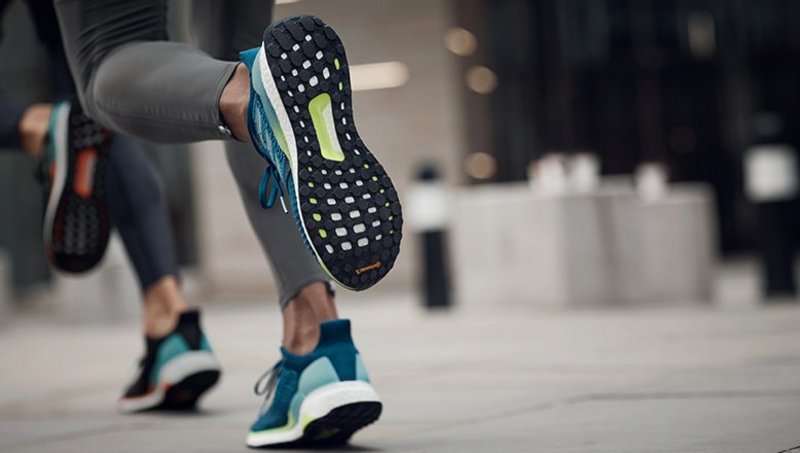Running in a Face Mask? With a Stroller? With Music? 10 Tips for Joggers in Times of Coronavirus
- Running is the top trend sport during the coronavirus crisis
- 10 tips from Continental for healthy jogging, issued in cooperation with sport physicians
- Information – for example on the risk of infection – for returning or experienced runners
- Good running shoes are essential – like models with the high-grip “Continental sole”
Hannover, Ma 14th, 2020. Amateur joggers in colorful outfits are a familiar sight in parks and forests, as well as on city sidewalks. Even before the advent of coronavirus, in Germany for example there were more than five million joggers. Although no official figures on the jogging boom during the coronavirus pandemic are available yet, it is obvious that far more people across the nation are now lacing up their running shoes. Sports clubs, swimming pools and gyms are still closed – or were closed for months. Some restrictions intended to prevent the spread of the virus have now been lifted, and engaging in some individual sports it now possible again, either outdoors or in one of the indoor sports facilities that are slowly opening again. However, there is still much uncertainty about how people can participate in other sports or games without making physical contact, so running is one of the few sporting activities that can be undertaken with no problems at all. Sports physicians are explicitly in favor of running outdoors: Sports, and open-air sports in particular, strengthen the immune system. Sports release adrenaline, which boosts and speeds up production of the body’s natural immune cells and lymphocytes, which reduces the risk of infection. Research shows that runners are up to 50 percent less likely to fall ill than couch potatoes. That said, there are many questions about jogging – especially in times of coronavirus. How high is the risk of infection while running? Should runners wear masks? What is the ideal training workload for beginners or returnees? Does it make sense to wear my old running shoes from way back when? Or run while pushing a child in a buggy? Will listening to music spoil my natural running rhythm?
When it comes to running, Continental has plenty of know-how and experience to offer: In cooperation with sports goods manufacturer Adidas, the technology company has developed high-grip soles for running and outdoor and hiking shoes. The rubber compound from the Continental labs in Hanover (Germany) gives the running shoes up to 30 percent more grip. Shoes with these soles provide optimum contact with the ground and outstanding power transmission – the same characteristics that distinguish Continental tires. “The performance of shoes with our soles can be compared with that of ultra-high-performance tires for sports cars”, says graduate chemist Konstantin Efimov, who is responsible for material development for tires and running shoe soles at Continental. “They have measurable, objective advantages. Slippage, for example, is much lower in comparison with conventional soles. Runners slip one to two millimeters less per stride.” This gives a runner a 35- to 70-meter advantage over the course of a full marathon − just over 42 kilometers. Competitive marathons may be out of the question right now, but a good running shoe is also an important factor in making your evening jog around the park a healthy sporting experience.
In close consultation with leading sport physicians, running coaches and professional athletes, in what follows, Continental answers some of the most important questions about running in times of coronavirus.
1. Running in a mask?
A mask that covers your mouth and nose makes breathing more difficult, which has a negative impact on your running rhythm and training performance, added to which there is no need to wear a mask in the open air because the risk of infection outdoors is lower than indoors. As a basic rule, nobody with symptoms of a cold, and certainly nobody with concrete symptoms of COVID-19, should engage in any sporting activity. Of course, it is possible to be an unwitting carrier of the virus without displaying any symptoms, but the coronavirus load that an infected person breathes out disappears quickly in the open air. Nevertheless, the following rules apply: When running alongside someone else, keep at least two meters between the two of you. When passing other walkers or runners, turn your head away. If you are running behind someone, keep at least 15 meters between you and the person in front – otherwise you will be running through a ‘cloud’ of air that they have breathed out. In sum: Run without a mask – but keep your distance.
2. How long should I run for?
People who are new to running subject their bodies to a process of adjustment. Bones, joints, ligaments, heart and blood vessels must become accustomed to their new, unfamiliar workload, so running is not about intensity, but about continuity. A weekly quota of two or three runs lasting 30-40 minutes is ideal for beginners and people who are returning to running. The recommended limit for good runners is 90 minutes. In principle, only running once a week means that you start again from scratch every time. Beginners should allow themselves two days to regenerate between runs. Regular runners should have at least one day off between runs.
3. How fast should I run?
Many people who were good at sport when they were younger think that they can pick up where they left off – which is a serious mistake. Many returning runners are disappointed at their current level of fitness and soon lose interest in running again. The key is to start at a slow pace and keep it up. Starting to train again too fast or too intensively often leads to strain injuries or fatigue. Running should be fun, not stress! The old rule of thumb for running is that your speed is just right if you can hold a conversation while running, and you should drop down a gear if you are too out of breath to speak. 80 percent of training should be done at a relaxed pace that feels like it’s below your full capacity; the other 20 percent can be intensive. This is also the best way to burn off fat. Because if you run too fast – gasping for breath is a sign that you are not getting enough oxygen into your lungs – you hardly burn any fat at all.
4. Is it better to run in the morning or in the evening?
Most people have two performance peaks a day. The first is usually between 9 and 11 a.m., the second between 4 and 7 p.m. Ideally, you should try to run during one of these time slots. Of course, your personal preferences and schedule also play a part. If you feel fit and raring to go at 7 o’clock in the morning – then go for it! Running after work is a good way of winding down after a stressful day, although running before work can be a good idea, too: Physical exertion releases endorphins, “happiness hormones” that help put you in a good mood and clear your head.
5. Should I only run before meals?
No, that is not a hard-and-fast rule, although running straight after a meal is not a good idea, either. After meals, you should wait at least an hour and a half to two hours before you go for a run. If you like to run in the afternoon, you will usually perform better if you have a light lunch and eat your main meal in the evening. If you go jogging before you go to work, as many people do, there is no need to eat anything beforehand. If you only run for 30 to 45 minutes, your body will have enough energy reserves left over from the day before. If you run for longer, a light breakfast, such as a banana, makes sense.
6. The park is full – where else can I run?
However nice it is to have company when you are running, in times of coronavirus it is better to find a quiet place to exercise. If your favorite course round the lake in your local park is too crowded, simply run around your neighborhood. When everybody else is out in the fresh air on a sunny Saturday afternoon, why not run on Sunday evening instead? After a while, many joggers find running monotonous because they always run round the same course at the same speed. So try to add a bit of variation, such as running your usual course the other way round, or running to the halfway mark and then turning back. Or why not simply take a left or right-hand turn and see where the path takes you
7. Should I stretch before or after running?
It is not absolutely necessary to do stretching exercises before you run, provided that you start at a normal pace. Stretching afterwards is more important because most beginners have muscle deficits. Stretching is used for the detonization or ‘accelerated relaxation’ of muscles. It is particularly important to stretch your calf muscles, but also your Achilles tendons and ankle joints. Running uses up a lot of energy. The faster you run, the more important muscular stability is - especially in the center of the body – so an accompanying muscle training regime also makes sense. There’s no need to go to the gym for this – exercises that involve using your own body weight are sufficient. Planks, side planks and push-ups strengthen and stabilize the muscles of torso, trunk and pelvic floor, which in turn will help to improve your running technique.
8. Can I push a stroller while I jog?
Opinions are divided when it comes to running with a pushchair – some people are opposed to the idea, while others don’t find it a problem. For the child’s sake, it is important to stick to the following rules: A baby should not be pushed along in what is known as a jogging stroller until it can hold its head up unaided. Pushing a stroller over even a slightly uneven path will cause quite considerable jolting to the child inside, so the baby’s neck muscles must be well developed to avoid injury. Basically, jogging with a stroller gives mom or dad a chance to go running despite their parental responsibilities.
9. What about listening to music on earphones while I run?
It may be music to your ears, but it can also alter your running rhythm and your breathing, which can cause beginners, in particular, to lose their rhythm. This, in turn, leads to what is commonly called a stitch. Breathing irregularly causes cramp in the diaphragm, which runners experience as a stabbing pain in the side. The only cure for a stitch is to stop running, stretch the muscles on the affected side and take deep breaths that fill the abdomen. Experienced joggers can listen to music while they run – it may even enhance performance and increase their motivation. When the body is subjected to a heavier workload, the pulse rate begins to synchronize with the rhythm of the runner’s movement, which in turn will depend on the rhythm of the chosen music. At optimum synchronization, the rhythm and tempo of the runner’s breathing, pulse and step frequency and the beat of the music will be identical. Experts recommend that joggers listen to tracks with 150 to 180 beats per minute (bpm). Popular streaming platforms offer compilations of running songs from all music genres with the appropriate bpm rate. A word of warning: Do not turn the volume up too loud, or you may not be able to hear runners or cyclists who want to pass you, or approaching cars.
10. Are my old running shoes still good enough?
If in doubt, don’t wear them. As a rule, beginners can take their first steps as joggers in an old pair of jeans and a cotton t-shirt, but on no account in the wrong shoes. Those old baseball sneakers are not the right footwear for running. The only correct option is a pair of purpose-made or, even better, individually customized running shoes. For example, adidas shoes with Continental soles – easily distinguished by the company logo – are highly recommended. They provide optimum grip and support a healthy running style. A jogger’s feet (and shoes) have to cushion the equivalent of three or four times their body weight – an extreme load by any standards. If your running shoes are not up to the job, you will soon run the risk of stress or strain injuries. Ideally, take your old running shoes – if you still have them – to the shoe store with you. The expert sales staff will look at the signs of wear and advise you on which new shoes to buy. If going to the store in person is difficult due to coronavirus restrictions, order two or three pairs in different sizes online. You should buy running shoes a size larger than your regular footwear – your feet will need some extra room because they will normally swell a little when you are running. Especially around the toes there should be about two centimeters of space. Make sure too that the shoe offers a little extra width, because your toes splay out when they hit the ground, increasing the width of your footprint.

Klaus Engelhart
Press Spokesman
Passenger Car Tires / Germany, Austria, Switzerland
- +49 511 938-2455

Michael Nehring
Manager Media Relations
Passenger and Truck Tires Region Europe, Middle East & Africa
- +49 0 511 938 2230


